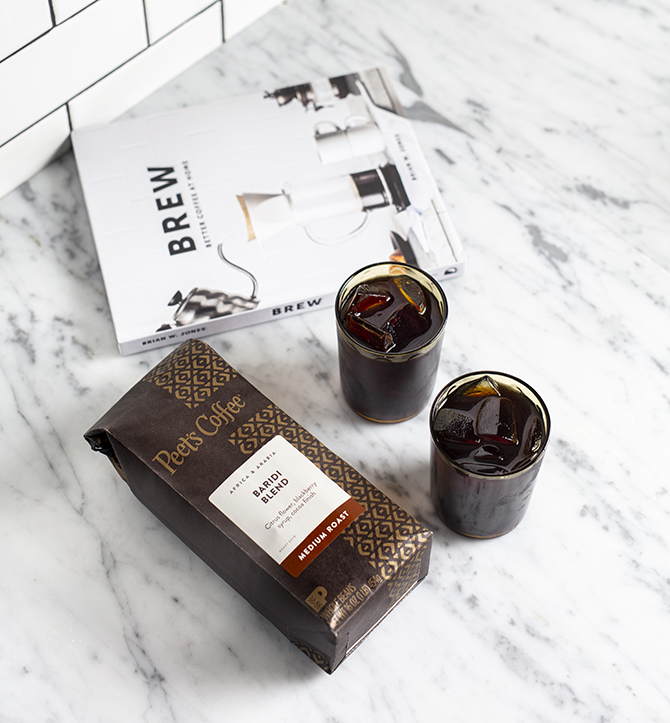
What’s the Difference Between Cold Brew and Iced Coffee?
We’re often asked if cold brew and iced coffee are the same thing. They’re not. From preparation time to flavor, there’s a specific distinction between cold brew and iced coffee.
TL;DR: basically, the “cold brew” method involves a slow brew style in which cold water is poured over coarsely ground coffee and left to infuse slowly for at least 12 hours in the refrigerator. When you’re brewing with hot water, the coffee is highly soluble, and it’s easy to “over-extract.” But cold water takes a lot longer to extract coffee flavors, hence the crazy-sounding brew time of 12 to 15 hours.
Iced coffee, by contrast, involves brewing a hot cup of coffee as you normally would … but brewing it directly over ice cubes. Also known as flash brewed, flash-chilled, or Japanese-style iced coffee, this technique makes a cup that’s bright, clean, and complex, with balanced acidity (that’s coffee-speak for mouth-watering). It requires a pour-over or drip set up and takes less than ten minutes. And if you’re into the details, read on!

Cold Brew Method
Cold brewing coffee is exposing the coffee to water for extraction without the element of heat. When you apply heat during coffee extraction, it releases compounds that aren’t released without it, which is why Cold Brew tastes different than hot coffee or iced coffee. No heat, and those elements stay in the coffee grounds, not the liquid.
To cold brew, start with your grind and measurements. You’ll want to measure and grind 250 grams (just over a half-pound) of freshly roasted coffee beans (we recommend Baridi Blend, which we crafted especially for cold brew) to the consistency of coarse sea salt. A finer grind will cause over-extraction during the brewing process, so make sure your coffee grind is coarse. Step two: Add ground coffee to your cold brewer and then slowly pour in 1 liter of cold, freshly filtered water. Allow the grounds to bloom for at least 30 seconds, then carefully pour in the remaining ¼ liter (250 ml) of fresh, cold water. Use the back of a spoon or whisk to gently push any dry grounds below the surface of water until all the grounds are saturated. We know, we know… the waiting really is the hardest part (was Tom Petty talking about cold brew?). But you must wait. Let the coffee brew for a minimum of 12 hours. You can brew at room temperature or in your refrigerator. Now we’re getting close: step four is to lift the filter and let the cold brew concentrate drain completely before discarding the grounds. To serve, dilute 1-part cold brew concentrate with 2 parts cold water. Adjust the strength to your taste.
With the Cold Brew method, a much higher concentration of coffee to water yields a better brew; try 5 parts water to one-part coffee. You can always dilute later. To see how it’s done, check out our Brew Guide for Cold Brew video here. (If you’re not used to weighing your ingredients, see the measurements in the table above.)
It’s also pretty straightforward to scale up and make a big batch of cold brew concentrate that can be stored in a sealed container for up to ten days in the fridge. Because it’s a concentrate, your cold brew will probably require less room in your fridge than you might expect. And if it tastes stale after only a few days, it might be a sign that you need to clean old coffee oils that are coating your equipment.
Flash Brewed Iced Coffee
Flash brewing is another way of describing flash-chilled coffee. For step one, let’s say you are using the pour-over Hario filter method. If you usually use a ratio of 16 parts water to 1 part coffee when brewing your coffee hot, halve the water and use only 8 parts water. For step two, make up the other half in ice cubes and put them directly into your glass server. As you pour the hot water over the coffee grounds, and it begins to seep through the filter and into the server, it will melt the ice cubes you placed there. The hot brew rapidly melts those ice cubes and adds volume to the final drink, which is why you need to reduce the quantity of brew water you add. If you end up with a finished drink that’s too strong, you can always dilute it with water to taste. But if you start off brewing too weak, you can’t add strength back in. Try it for yourself with our Flash-Chilled Off the Grid recipe.
As soon as the brew is completed, bottle it and put it in the refrigerator. Brewing with hot water means you rapidly extract bright notes. Cooling it straight away by putting it into the refrigerator slows down oxidation—or the loss of flavors—and keeps your flash-chilled iced coffee tasting great, capturing those bright notes.

Cold Brew Flavor and Acidity
Brewing cold from start to finish results in bold, smooth, refreshing coffee with lower acidity than coffee that’s been brewed hot and then iced. Cold brewing extracts different flavor notes than hot, resulting in a smoother cup with less bitterness. Because there isn’t heat to extract, you won’t taste the extremes on either end, resulting in a smoother cup. This explains why so many experience Cold Brew as being “less bitter.” Since the slow extraction delivers a mellower drink, it’s free of the extreme flavors you would get in such a long extraction period if the water were hot. Even after 15 hours of infusion in the refrigerator, the cold brew method won’t produce bitter, stewed notes.
The specific notes that cold brewing will extract depends on the coffee, of course, but you might notice that a coffee brewed using the cold brew method has more chocolatey notes and the same coffee brewed using the flash-chill method has more caramel. For example, our Sun Catcher showed these notes when cold brewed: “Arnold Palmer and honeysuckle with chocolate and caramel at the finish.” And these notes when flash-chilled: “Bright, very dark chocolate forward in this method, with lemony juiciness.”
Iced Coffee Flavor and Acidity
Acidity in coffee is a good thing. Yep, it might sound counter-intuitive, but acidity in coffee equals liveliness. It’s a desirable, sharp, and pleasing sensation that heightens coffee’s flavor. High acidity coffees taste bright, pungent, or tangy. Acidity may be high, medium, smooth, or completely lacking, in which case the coffee might taste flat or dull. Since iced coffee is brewed using heat to extract all those great flavors, a cup of iced coffee will hold more nuance. If you flash-chill a natural coffee from Ethiopia, for example, you’ll get a wider range of those wild, winey, fruity flavors. Costa Rica on ice? You’ll get all of those bright, Meyer lemon-y notes. For origins and blends that take advantage of coffees with full, bright, flavors, do a taste test between brewing hot and cold and see if you can taste the difference.
Does Cold Brew Have More Caffeine Than Iced Coffee?
The idea is this: the more physical contact the coffee matter has with water, the quicker the coffee will extract. When brewing your coffee, the caffeine content moves from the ground coffee beans into the water—just like flavor. Things that can affect caffeine extraction are water temperature, surface area of the ground coffee, and extraction time—how long your coffee is in contact with the water. Cold brewing uses coarse grounds and a long extraction time, resulting in a cup that will have slightly more caffeine than one brewed hot.
What Coffee Beans Make a Good Cold Brew?
At the end of the day, as with all things coffee, your taste reigns supreme. Experiment and see which method you prefer. We have our viewpoint on what coffee is best suited to cold, and we created Baridi Blend to reflect that taste. But we’ll never tell you your preference is wrong—your palate is your own best judge. So, try it with Costa Rica Aurora, Costa Rica meets Kenya in this bright, electric light roast with notes of lemon bar, black cherry and molasses. Or try it with our Brazil medium-roast single origin, a body-driven single origin coffee with notes of hazelnut and caramel that’s naturally processed in the Brazilian sun. Check out our Coffee Finder and see what sits best for you.
What Coffee Beans Make a Good Iced Coffee?
A great option is any coffee with great aromatics. We think that the sweet-forward fruit notes inherent in East African coffees shine in a cold cup. Which is why we developed and suggest medium-roast Baridi Blend, highlighting the fruity notes of East Africa and Central America, as the perfect blend for iced coffee. We’d also recommend two single origin coffees that are lightly roasted. Experience the elegance of Ethiopian Fancy or the juicy and complex notes of our Kenya Auction Lot. Or take it up a notch with our recipe for Minty Iced Coffee. A homemade mint syrup adds a cooling sweetness that makes for an exceptionally refreshing iced coffee.
What About Nitro Cold Brew?
Are you equipped to make nitro cold brew at home? The reality is, probably not. Although nitro cold brew has become increasingly popular, investing in very specific, expensive equipment is a big hurdle to brewing nitro cold brew at home. So stop by one of the Peet’s coffeebars that serve this refreshing beverage on draft. Our Nitro Cold Brew features our signature, bright Baridi cold brew, infused with nitrogen for a foamy head and a velvety cascade.
| Iced Coffee | Cold Brew | |
|---|---|---|
| Brewing | Brew hot | Infuse cold |
| Coffee to Water Ratio | 1:8 plus over 8 parts ice |
1:5 |
| Coffee to Water Measurement | 4 tbsp ground coffee brewed with 6 fl oz hot water over 6oz ice cubes | 1/4 pound ground coffee (1 1/2 cups) to 2 1/2 cups cold water |
| Grind | Medium | Coarse |
| Brew Time | Immediate, as with any hot brew, then chill in fridge | 12 to 15 hours infusion in refrigerator |
| Serve | When chilled to your taste preference | After 12 hours, dilute the concentrate with 1 part cold brew to 2 parts cold water |
| Best Blends |
Baridi |
Baridi Costa Rica Aurora Single Origin Brazil Luminosa Breakfast Blend Big Bang Zenith (Limited Release) |


